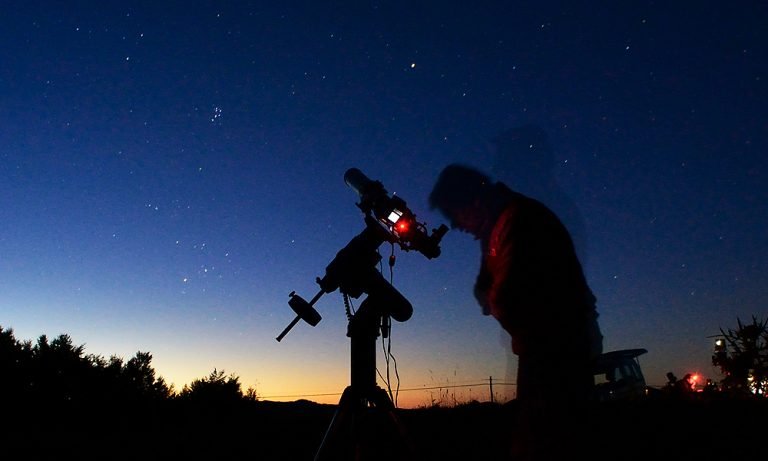12 Best Budget Telescopes in 2024 [Maximum Value for Money]
Looking for an inexpensive telescope that’s pretty good but doesn’t cost a fortune? You are in the right place.
Dobsonians offer the most value for money, but most reflectors are great for beginners.
The best budget telescope has a large aperture, is easy to use, and is reasonably portable.
Best Budget Telescope
1. Orion SkyQuest XT6 Classic Dobsonian Telescope
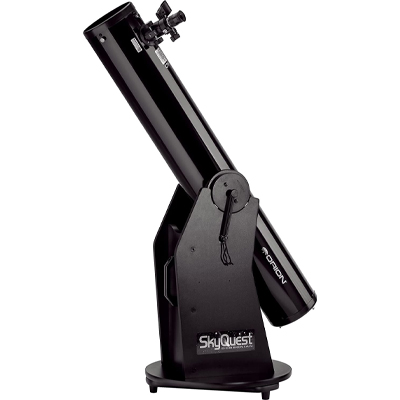
Moving on to a more advanced scope, we were very excited to try out the amazing Orion 8944 SkyQuest XT6 Classic Dobsonian Telescope. This beauty has a massive 6” aperture, giving astounding views of the night sky.
This best cheap Dobsonian telescope stands on the floor on a stable Dobsonian base that provides vibration-free imaging, even when viewing at high power. It features smooth motions to make tracking of celestial objects very easy, even for our younger children.
Larger telescopes usually require polar aligning, but the Orion 8944 SkyQuest XT6 does not. Simply set up, and you are ready to point-and-view your object. This best rated telescope for beginners comes with a 1.25 inch Rack-and-pinion focuser and an EZ Finder II.
It includes a Sirius Plossl 25mm eyepiece that gives 21x magnification. It weighs 20 lbs and has a convenient carry handle, making it portable to take along on a stargazing trip. This 6” Dobsonian is probably the best telescope you can buy at a very affordable price.
What can you see with it
The 6″ diameter f/8 parabolic mirror is fantastic for Moon and planetary views and also has enough light for deep-sky viewing of nebulas, galaxies, and distant star clusters.
What’s the drawback
There are no real drawbacks with the views on this 6” scope. More advanced users may prefer a computerized mount, but we were very comfortable with the smooth motion of the mount.
Best for
Families and serious beginners to invest in a great purchase. You will enjoy stargazing for years to come without the need to upgrade to a more expensive model.
2. Orion StarMax 90mm TableTop Maksutov-Cassegrain Telescope
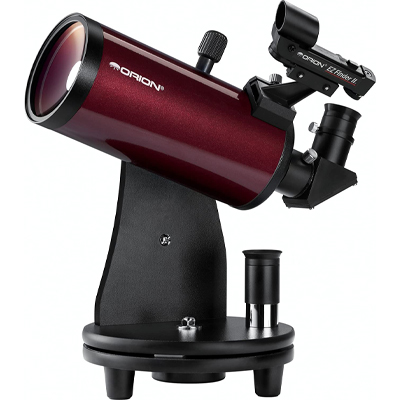
The Orion StarMax 90mm TableTop Maksutov-Cassegrain Telescope comes with a compact and lightweight design, perfect for taking along on a family evening picnic or a weekend trip.
Weighing only 6.5 lbs when assembled, the scope is your perfect grab-and-go option. It has a neat tabletop base that provides a stable viewing foundation. All you need is a table or flat surface to stand it on. There is no fussy tripod – a bonus that I really enjoyed.
If you do prefer a tripod, you can attach one using the 3/8″ or 1/4″-20 threaded post. There are two 1.25″ eyepieces, a 25mm and a 10mm. Also included is an EZ Finder II reflex sight for easy aiming and a 90-degree mirror diagonal for great night sky viewing.
What can you see with it
The larger 90mm aperture and longer focal length gather enough light for beautiful views of deep space objects. This is an affordable telescope that can see galaxies, globular clusters, and nebulas. The moon and planets of our solar system were also amazing to see in clear detail.
What’s the drawback
Lower priced amateur telescopes don’t always offer the same viewing quality as more expensive models. However, this 90mm aperture amazed us with the views of planets and far-away galaxies.
Best for
Kids and beginners to stargaze. These amateur astronomical telescopes make great gifts for enthusiastic young astronomers. It won’t disappoint!
3. Orion StarBlast II 4.5 Equatorial Reflector Telescope
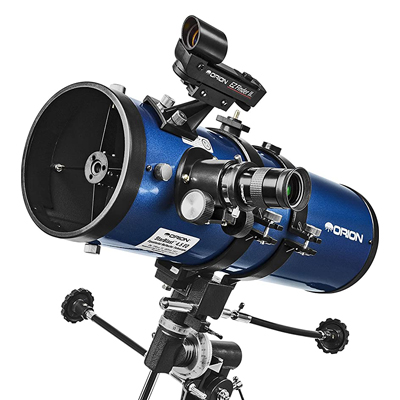
Any family will enjoy the Orion StarBlast II 4.5 Equatorial Reflector Telescope. Although it is a bit heavier than previous models, it is still easy to transport and gave us stunning views.
The 114mm aperture best budget telescope comes with 2 Sirius Plossl eyepieces, a 25mm and a 10mm, providing 18x and 45x views. It also includes an EZ Finder II reflex sight and an adjustable-height tripod, which is great for smaller children.
The EQ-1 mount makes it easy to keep moving objects centered in the eyepiece. It has handy slow-motion controls, so you don’t lose the object as you move the mount. Using the MoonMap 260, we were able to find and learn about specific features on the Moon.
What can you see with it
Using this cheap reflector telescope, you will have a blast viewing Venus, Mars, Jupiter, and Saturn. On a dark night, you could even see the blue dot of Uranus. The Moon is amazing, with clear views of craters and the barren lunar landscape.
What’s the drawback
A budget telescope does not always offer the same viewing quality as more expensive models as they have cheap optics. However, this 4.5” aperture amazed us with the views of planets in the solar system.
Best for
Kids to look at the sky and for beginners to stargaze. This is a good telescope for cheap price and makes a great gift for a young newbie astronomer.
4. Celestron NexStar 130 SLT Series Newtonian Reflector Telescope
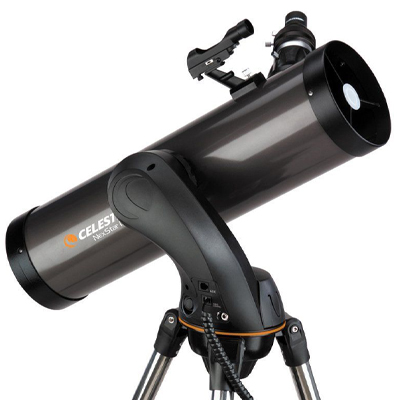
This is the most expensive of the affordable telescopes that we reviewed. It comes with a motorized altazimuth mount, fully computerized hand control, and SkyAlign. This amazing feature allows you to align on any three bright celestial objects, making for a fast and easy alignment process.
There is also a StarPointer Finderscope to help with alignment. My teen children, who are great with touchscreens, soon got it going for us. It also comes with a pre-assembled, adjustable steel tripod, ideal for the smaller children to get perfect sky views.
This best computerized telescope under $500 has a 130mm aperture, offering clear, bright views of the solar system and other celestial objects. We were able to see the Moon in detail as well as Saturn’s rings and Jupiter’s cloud bands. It comes with a Red Dot StarPointer Finderscope and 2 eyepieces, a 25mm, and a 9mm.
The SLT stands for Star Locating Telescope, and we were blown away by the database of more than 4,000 stars, galaxies, nebulae, and more. The telescope can easily locate your object with pinpoint accuracy and then tracks the object automatically as it moves across the sky.
What can you see with it
See brilliant detail of the Moon’s craters, valleys, and mountains. We also saw Saturn’s rings and Jupiter’s cloud bands. Far-away star-clusters appeared bright and in great detail.
What’s the drawback
This is a great scope for beginners and more experienced stargazers. You will need some computer experience, or have a teenager around to help you.
Best for
Beginners and more advanced stargazers. This scope makes a great buy and will give years of stargazing without the need to upgrade.
5. Celestron C90 Mak Spotting Scope
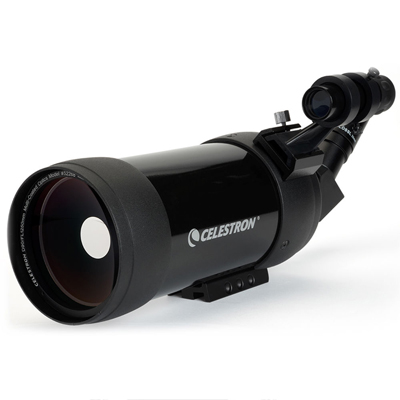
The Celestron C90 Mak Spotting Scope has a larger aperture at 90mm, and we could see a difference. Images were clearer and we could even view more distant, dimmer celestial objects.
This best low cost telescope has a Maksutov-Cassegrain Optical Design and a 1250mm focal length. It is compact and portable, ideal for taking along for a weekend away from the city for some family stargazing.
We enjoyed the eyepiece angled at 45 degrees for more comfortable viewing. It made it easier for younger children to use. The scope comes with a 32mm eyepiece that offers 39x magnification.
The tripod is sturdy and easy to set up (comes only from Optics Planet kit). It features a 3-way pan head with a quick release plate, adjustable tension, and a geared elevator. The cheap night scope has an included Image Finderscope and comes in a Nylon backpack.
What can you see with it
You will be able to see the craters on the moon and the rings of Saturn. We also saw fainter star clusters and nebula. The kids were very excited to see the 3 stars of Orion’s belt up close.
What’s the drawback
A cheap telescope for beginners may give less clear images of far-away celestial objects. As beginners, we are very happy with this scope.
Best for
Best for beginners to stargaze. Ideal for a family with kids to start a hobby. It makes a fun hobby for a couple to take along on a romantic weekend away.
6. Orion GoScope III 70mm Refractor Telescope Kit
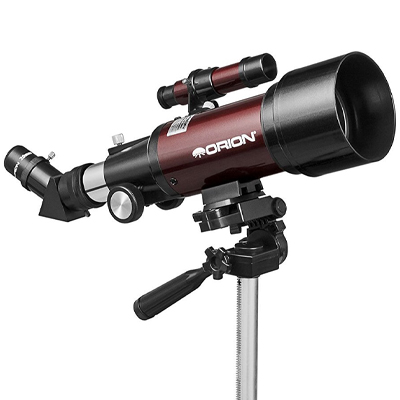
My teen children won’t go anywhere without a backpack, and having a telescope complete with a backpack is a bonus! It holds everything they need for a night of stargazing.
The Orion range offers cheap but good telescopes for beginners. This scope has a 70mm aperture, large enough to collect enough light for great views of celestial objects. It includes a 5×24 Finder Scope for easy aiming and two 1.25″ Kellner telescope eyepieces, a 20mm and a 9mm.
As beginners, it is very useful to have help. The scope comes with an Orion Exploring the Cosmos book and a Star Target Planisphere that shows which constellations are visible any night of the year.
This is one of the best affordable telescopes and is very easy to use. Simply follow the alignment procedure and then aim at the object you want to view. It is also great for daytime viewing and my hubby enjoyed spotting some rare feathered friends.
What can you see with it
Using the scope, we tracked the main stars in constellations like Orion the Hunter and Cancer the Crab. We also saw amazing views of the moon. Seeing the craters sends shivers down your spine! It is also great for terrestrial viewing – birds, animals, boats, and ships.
What’s the drawback
Lower price scopes do not have the detail of view offered by more expensive telescopes. However, as a starter scope, we were very happy with the views we got.
Best for
This is a good affordable telescope for families wanting to start stargazing as a hobby. The kids will love the portable backpack that easily holds everything you need.
7. Celestron AstroMaster 130EQ Reflector Telescope
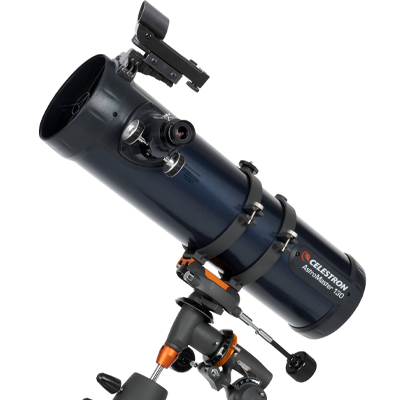
The Celestron AstroMaster 130EQ Reflector Telescope is a powerful Newtonian reflector telescope with a 130mm aperture for awe-inspiring views. It features fully-coated glass optics and comes with 2 best budget telescope eyepieces, a 20mm, and a 10mm.
The scope has a design for easy portability, with an adjustable travel tripod. This is great for our smaller children, making it easy for them to view the sky. You do not require tools for assembly.
The mount is a manual German Equatorial AstroMaster mount. It has 2 slow-motion control knobs that allow you to make precision adjustments to follow an object as it tracks across the sky.
This makes it easy to keep the target object centered in the eyepiece and not lose it just when you are seeing great views! The longer focal length of 1000mm gives bright and clear views. Also included is a StarPointer Red Dot Finderscope.
What can you see with it
Using this good budget scope, we saw fabulous images of the planets, including Saturn, Jupiter, Venus, and Mars. We also saw craters, mountains, and valleys on the Moon.
What’s the drawback
For more advanced users, a lower-priced scope may not offer the clarity of views they expect. As beginners, we are very happy with the clear views offered by these best budget telescopes.
Best for
Kids, beginners, and families to explore the night skies. It makes a great family hobby, ideal for getting kids out of the house and into the open air.
8. Sky Watcher Skymax 127 Telescope
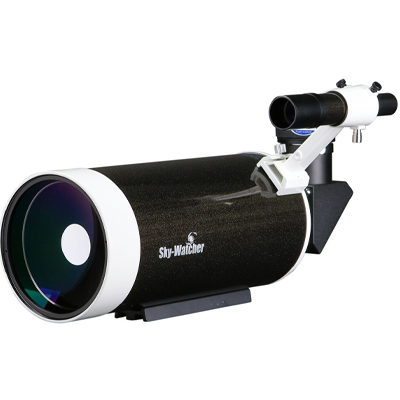
The Sky Watcher Skymax 127 Telescope has a Maksutov-Cassegrain design with a 127mm aperture. At a slightly higher price than the other models we reviewed, it does have one drawback – there is no mount.
If you don’t have a mount, you will need to buy one, which adds to the price of the setup costs. To attach a mount, the scope has a black V-style dovetail plate.
The optics on this scope are fully multi-coated and of a high-quality. The scope comes with a 28mm 2″ LET eyepiece that gave us great views of the moon, planets, and star clusters. Also included is a 6×30 Finderscope and a 2″ 90 degree Star diagonal.
Weighing only 12 lbs without the mount, it is very portable, and we took it along on a night outing to view the stars. We have an altazimuth mount, so that came along as well.
What can you see with it
Using the scope, we viewed the main stars in constellations like Orion the Hunter and Cancer the Crab. We also saw amazing views of the moon – craters, valleys, and mountains.
What’s the drawback
This scope does not come with a mount. Buying a good mount will add to the price.
Best for
Kids to view the sky and beginners to start enjoying stargazing. Makes a great gift for a budding young astronomer.
9. Celestron AstroMaster 70 AZ Budget Telescope
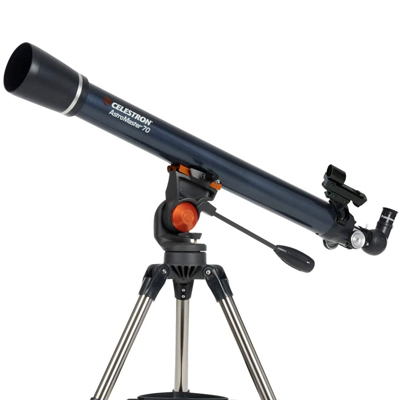
Another 70mm aperture scope that offers great views for beginners is the Celestron AstroMaster 70AZ. This scope has a refractor design and is ideal for both terrestrial and celestial viewing.
This best low-budget telescope features fully-coated glass optics for clear, crisp images. It has an Altazimuth mount for easy control. An altazimuth mount will move the telescope up and down or left and right. It also makes for easy viewing of terrestrial objects.
Even my younger children could operate it without a problem. For added ease of use, it comes with a permanently mounted StarPointer.
The tripod is sturdy with 1.25″ steel legs and comes pre-assembled. It also offers a deluxe accessory tray to hold all our bits and pieces. Two eyepieces allow a choice to get the best views. The first is 20mm with a magnification of 45x. The second is 10mm with a magnification of 90x.
What can you see with it
You can see the craters on the moon and the barren lunar landscape, and the planets. You can see the moons of Jupiter and the rings of Saturn.
What’s the drawback
More experienced users would probably want crisper and clearer views of far-away galaxies and nebula.
Best for
Best cheapest telescope, great for families to use as a bonding hobby to get out into the open. The scope is very easy to use. It comes with a pre-assembled tripod – a perk for people like myself who are useless at DIY!
10. Meade Infinity 102mm Altazimuth Refractor Telescope
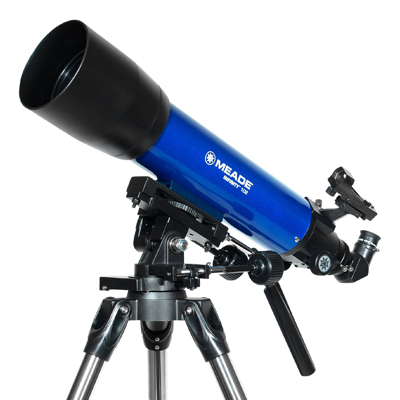
What is a good inexpensive telescope? It is important to ensure that a cheap telescope comes with all the bits and pieces one needs. Nothing is more frustrating than finding you are missing some vital component.
The Meade Infinity 102mm Altazimuth Refractor Telescope does not have that problem. The scope includes everything one needs and we were soon viewing the Moon and planets.
The scope has a 102mm aperture, perfect for delivering bright, detailed images both on land and in the sky. It stands on a high-quality Altazimuth mount that has slow motion controls.
My younger children found it easy to use and could track an object across the sky without losing it! The 3 included eyepieces offer low, medium, and high powered magnification. To get us started, the Bonus Autostar Suite Astronomy planetarium DVD has over 10,000 celestial objects to choose from.
What can you see with it
Using this good amateur telescope, we saw craters, mountains, and valleys on the Moon. We also saw the rings of Saturn and the moons of Jupiter. Some fainter objects like dim star clusters looked amazingly bright and awesome.
What’s the drawback
For more advanced users, good telescopes for cheap may not offer the clarity of views they expect. As beginners, we are very happy with the 3 eyepieces that give low, medium, and high magnification.
Best for
One of the best inexpensive telescopes for kids and beginners to explore the night skies. It makes a great family bonding hobby, ideal for getting kids away from the TV. Also great for land viewing – birds, animals, nature, and ocean ships.
11. Sky Watcher Evostar 72 APO Refractor Telescope
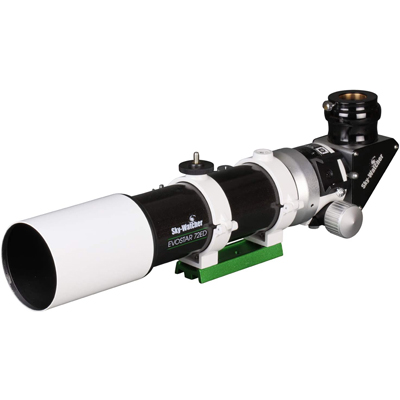
Now that we are becoming more experienced stargazers, we decided to try our hand at some astrophotography. The Sky Watcher Evostar 72 APO Refractor Telescope is a well priced and versatile scope, ideal for both beginners and more experienced stargazers.
It features a 72 mm apochromatic refractor and a 420 mm focal length. Using high-quality glass optics, it offers sharp images that have amazing color and minimal aberrations. The scope comes with a dual-speed 2 Crayford-type focuser with a 1.25 adaptor.
The scope is small and lightweight and arrives in a sturdy aluminum case, making it easy to transport for a stargazing outing or a weekend in the country. It does not come with a mount, which is a drawback. You will need to use an existing mount or purchase one if you don’t have a mount. This will add to the price of the setup.
Using the 10:1 Dual-Speed Focuser, it is easy to find and view any celestial object we chose. Even my younger kids are able to operate these cheap telescopes for astrophotography.
What can you see with it
Using the scope, we viewed the Moon, planets in the solar system, star clusters, and nebula. We also got fabulous photos to show off to friends and family!
What’s the drawback
This scope does not come with a mount. Buying a good mount will add to the price.
Best for
Beginners and more advanced stargazers. This is the best telescope for astrophotography under $500. This scope will help to advance your skills and take you into the exciting world of astrophotography.
12. FunScope 76mm TableTop Reflector Telescope
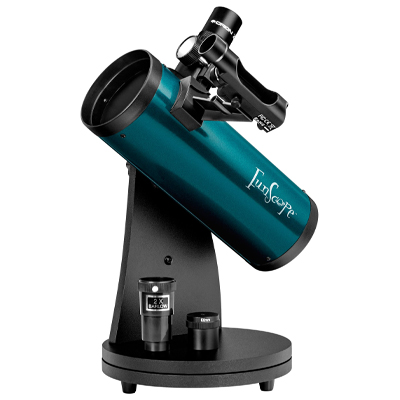
What is the best affordable telescope? The FunScope 76mm TableTop Reflector Telescope is a great first telescope for beginners and families. Being lightweight at less than 4lbs, it is extremely portable and ideal for taking on a weekend trip away from the city lights. It has a handy tabletop mount, making it very fast and easy to set up.
The cheap tabletop scope has a 76mm aperture, which collects 60% more light than typical 60mm beginner telescopes. Included with the scope are 2 eyepieces, a 20mm 15x eyepiece, and a 6mm 50x eyepiece.
It also has a Red Dot Finderscope that makes it easy to aim at objects in the sky. It was super exciting to use the Orion MoonMap 260 and identify the craters and lunar features that we saw through the scope.
What can you see with it
Using the FunScope, we saw amazing views of craters on the Moon. We also viewed bright planets in our solar system like Saturn and Jupiter and saw brighter sparkling star clusters and nebulas.
What’s the drawback
Lower price scopes do not allow views of very faint star clusters and dimmer celestial objects. But, as a start, we were happy with the magnifications we got with the 2 included eyepieces on this best cheap telescope.
Best for
A great cheap telescope for kids to look at the sky and for beginners to stargaze. Ideal for taking along on a backpacking adventure, a camp, or a weekend away from city lights.
What to Expect From a Cheap Telescope?
Under $100
For under $100, you will get a very basic scope with an aperture of around 60mm. These cheap telescopes are great for getting an idea or whether you will enjoy stargazing as a hobby. You can then invest in a larger model once you are hooked. For under 100, you will get amazing views of the Moon.
$100-$200
In this price range, you can expect to get a larger aperture of around 70mm to 112mm. Mounts can be altazimuth mounts, which offer manual smooth, slow motion controls. Some telescopes come with more than one eyepiece offering different magnifications.
$200-$300
Cheap scopes between $200-$300 have larger apertures ranging from 90mm to 130mm. The optics are of higher quality and can be fully-coated for stunning views. A scope in this price range is ideal for a family wanting to start stargazing as a hobby. Mounts can be altazimuth mounts, which offer manual slow motion controls.
$300-$400
Paying more gets you more power and brighter images! Apertures can range from 120mm upwards. You will usually get more than one eyepiece with different magnifications. Mounts are manual altazimuth mounts which are easy to operate and allow you to track an object across the sky.
$400-$500
Telescopes in this price range are ideal for both beginners and intermediate stargazers. Many are suitable for astrophotography. You will be able to get clearer views of more distant celestial objects. Many of these scopes come with software to guide you on your stargazing journey.
Over $500
At over 500, you can expect to buy a scope with a computerized GoTo mount. This mount will automatically track your object as it moves across the sky with no manual intervention required. Apertures will range from 120mm upwards. Additional eyepieces are also included, and astrophotography is a must-try.
What Can You See With a Budget Telescope?
Buying a budget telescope does not mean that you will be unable to view some amazing celestial objects. Here are some examples of what you can see with a best value telescope.
Moon
Even the cheapest telescope of under $100 gives great images of the moon. Using a scope with an aperture of 60mm to 70mm will be able to see craters, valleys, and mountains of the lunar landscape.
Saturn
To view Saturn, a cheap telescope for beginners of $300 or more is ideal. With an aperture of 70mm upwards, you will see the rings that surround the planet. The larger the aperture, the more detail you will see. Stronger scopes will give images where you can see the rings separate from the planet.
Mars
How about seeing Martian polar caps and the major dark surface features when Mars rotates? You can do this with a cheap telescope to see planets with a 90mm to 130mm aperture.
Uranus and Neptune
Uranus and Neptune are also visible as very small discs using a cheap powerful telescope with an aperture of 90mm upwards.
Star clusters and galaxies
Star clusters and galaxies appear as bright diffuse objects. You can enjoy viewing them with the best cheap telescopes of 90mm upwards.
Comets and asteroids
To see great views of faint comets and brighter asteroids, you need decent telescopes of 130mm and bigger.
Pluto
Pluto is very faint and hard to see. You will need a larger scope of 200mm to see it as a tiny dot in the sky.
If You Have a VERY Tight Budget Then do This
If you have a very tight budget, you have to consider this. It might be hard, but telescopes under 200$, especially department store fare that touts their magnification abilities above all else, should be avoided! You won’t get a good experience, throw your money, and worst of all, maybe even lose your interest or enthusiasm for stargazing.
As such, you should rather pick a good pair of binoculars. They can surprise you since you can actually see planets such as Jupiter, the Galilean moons, even faraway places like the Orion Nebula and distant galaxies. Binoculars are considerably cheaper than a decent telescope, and can also be used for another hobby like birding, or other outdoor sporting activities.
For backyard astronomy, most people recommend a 7×50 or 10×50 set of binoculars (the largest lenses you can comfortably hold)
But if you really want an inexpensive option for a telescope, the Celestron FirstScope may be worth it.
It is a reflector telescope, albeit a decidedly barebones one with just a 76mm aperture. However, it is made specifically for someone’s first experience in using a telescope, and it can actually provide a good experience overall.
Related: 5 Best Tripods for Binoculars (Astronomy) in 2020
How to Choose a Budget Telescope?
Aperture
It should have 2.8 inches – 70 mm, at least. Larger aperture lets you see fainter objects. The aperture is one of the most important aspects, and the larger they are, the better! Frankly, it is the most important aspect of a telescope.
Eyepieces
The lower the number, the more it magnifies, and they can be used on different telescopes. A good telescope should have at least 2 eyepieces, one of which should be at least 25mm.
Focal length
Magnifying power depends on focal length. It should be at least 1000mm for versatility. Magnification of 50x per inch is good – a telescope with an aperture size of 3.5 inches and a focal length of 35 inches has a focal ratio of f/10.
Weight and size
Telescopes vary in weight from 15lbs to 300 lbs. Most telescopes can be broken down into 3 subsections for transportation: The optical tube assembly, the telescope mount, and the tripod or base. It all depends on you and your method of transportation.
Mount
There are many types, but here are the top 3:
- Altazimuth – They are very sturdy and durable, move vertically and horizontally, and they may be the best choice for kids. The Dobsonian is an example of this Altazimuth mount
- Equatorial – Good for those with a bit of experience; for beginners, it can be complicated. They allow the telescope to move to the celestial north-south, and in the east-west axis.
- Computerized mounts – They have “go-to” buttons, automatically tracking what you want. They can take a bit of time to set up, though. It makes stargazing easy, on the other hand.
Also read:
- 5 Best Schmidt Cassegrain Telescopes Worth the Money (2020)
- 5 Best Maksutov-Cassegrain Telescopes Worth the Money (2020)
- 5 Best Star Projectors in 2020 [for Home Planetarium]
FAQ
What is the best inexpensive telescope?
The best inexpensive telescope is the FunScope 76mm TableTop Reflector Telescope. At a great price, it has a larger 72mm and a handy table-top mount. It also comes with 2 eyepieces.
What is the best affordable telescope to buy?
After our reviews, I would recommend the Orion GoScope III 70mm Refractor Telescope as the best affordable telescope to buy. It comes with a handy backpack and has a 70mm aperture for crystal clear views.
What is the best telescope for under $100?
The best telescope under 100 is the FunScope 76mm TableTop Reflector Telescope. At this great price, you get a 76mm aperture as opposed to the more common 60mm apertures found on an inexpensive telescope.
What is the best telescope for under $200?
The best telescope under 200 is the Celestron AstroMaster 70AZ. It has a 70mm aperture with a refractor design that gives great terrestrial and celestial views.
What is the best telescope for under $300?
The Celestron AstroMaster 130EQ Reflector Telescope is the best telescope under 300 that you can buy. It has a 130mm aperture for awe-inspiring views. It features fully-coated glass optics and comes with 2 eyepieces, a 20mm, and a 10mm.
What is the best telescope for under $400?
The best telescope under 400 is the Meade Infinity 102mm Altazimuth Refractor Telescope. It comes with everything you need to start and features a 102mm aperture for great views of the moon, planets and other celestial objects.
What is the best telescope for under $500?
The best telescope under 500 is the Sky Watcher Evostar 72 APO Refractor Telescope. It offers astrophotography functionality and a 72mm apochromatic refractor aperture. The scope comes with a dual-speed 2 Crayford-type focuser with 1.25 adaptor.
What is the best starter telescope?
For a starter scope, the Meade Infinity 102mm Altazimuth Refractor Telescope is a great choice. It has a larger 102mm aperture and comes with a precision Altazimuth mount with slow motion controls. There are 3 included eyepieces, offering low, medium, and high powered magnification.
How much does a decent telescope cost?
For a beginner, you can expect to pay around $300 to $500 for a decent telescope. A purchase like this will last for many years and keep you excited without having to upgrade.
How much does a really good telescope cost?
A really good telescope will cost $500 or more. Depending on your budget, you can spend well over $1000 on a fully computerized scope with all the bells and whistles.

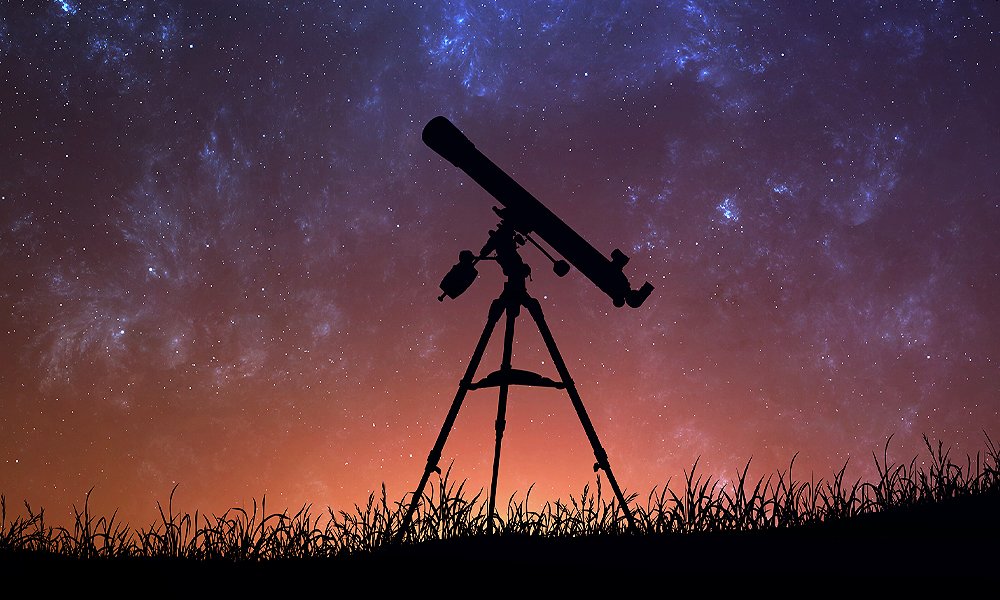
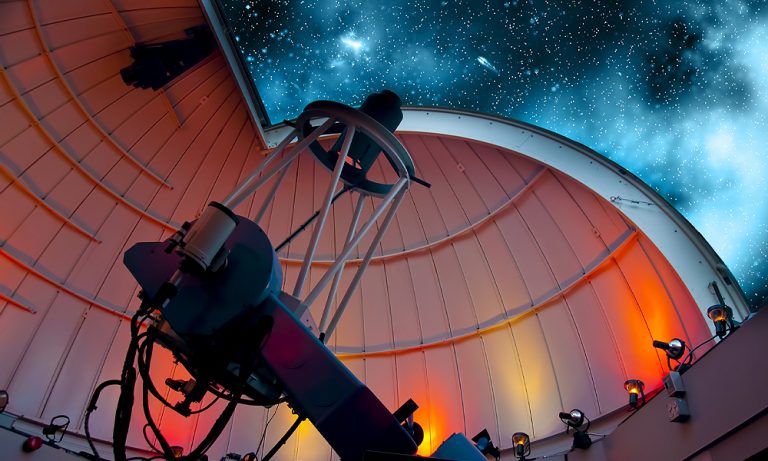

![12 Best Refractor Telescopes Actually Worth the Money [2024]](https://www.planetguide.net/wp-content/uploads/2019/12/refreactor-telescope-768x461.jpg)
